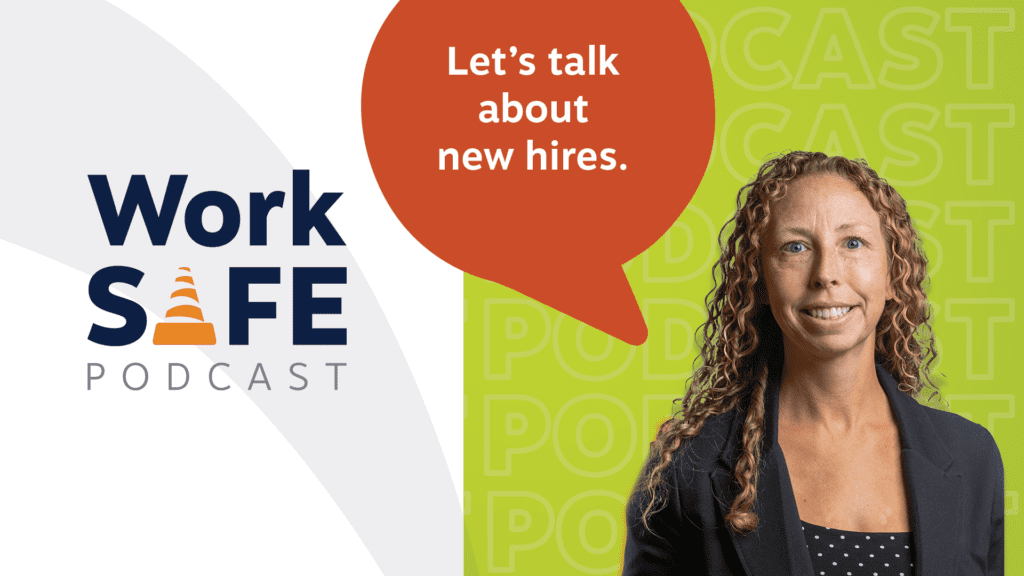On this episode of the WorkSAFE Podcast, we sit down with return guest Sheila Schmidt, Safety and Risk Services Manager at MEM. She has been working with businesses for more than 20 years to keep employees safe.
Despite significant advancements in workplace safety over the years, new hires continue to face a disproportionately high risk of injuries on the job. Fostering a safe work environment starts with equipping team members, especially new ones, with the knowledge and tools they need to stay safe from day one. Employers can do this by developing a strong new hire onboarding process.

Listen to this episode of the WorkSAFE Podcast, or read the show notes below.
Why are new hire injury rates so high?
Year over year, new hire injury rates present employers with a challenge. Workplaces are getting safer, and technology is improving every day. Why are new employees injured on the job so frequently?
“I believe it’s based on two things,” Schmidt pointed out. “One is math. We have so much turnover and movement across so many industries that we’re just seeing more and more new hires than we have in the past. So we have more new hires than we’re used to. Also, we’re pushing those new hires out faster. They’re usually filling vacant spots and we need them to hit the ground running.”
Common sense isn’t a safety strategy
Due to quicker turnover and higher expectations, many employers leave new hires to figure things out and rely on their own ‘common sense’. But this isn’t a safety strategy.
“We cannot simply rely on common sense,” Schmidt challenges. “You truly have to educate your employees, make them aware of the hazards, and provide them with a safe working environment and not just expect them to know better or do better.”

The importance of new hire onboarding
New employees can only contribute to growth if they are safe and properly trained. Taking the time to educate them ensures that growing your workforce doesn’t cost you more. “While employers are in a hurry to get good people into those positions, this is the time more than ever to slow down,” Schmidt shared.
Creating a strong new hire onboarding process
A strong onboarding process is about more than just paperwork and orientation. “Make sure you get the right people in the positions and make sure that they are properly onboarded so that you can avoid those illnesses, those injuries from throwing them out possibly before they’re ready. Having a strong onboarding process in place is going to help you do that.”
Set expectations early
Safety will compete alongside other workplace focuses: customer service, productivity, and role responsibilities. Employers should set the stage early and ensure safety is presented as essential. Introduce employees to all safety processes and rules you expect them to follow.
Choose your mentors carefully
Peer-to-peer training is often part of the new hire onboarding experience. Choose your mentors carefully. Employee leaders should have good communication skills and be strong examples of workplace safety. In addition, they should have the confidence to address unsafe behavior when they see it and offer correction.
Schmidt highlights that it’s important not to ‘crack the culture’ you build around safety by undermining your own rules and processes. For new hires, much of their early knowledge comes from watching and learning from those around them. But as soon as you ignore the rules you set or make exceptions, safety efforts quickly become worthless.
Encourage questions and feedback
Asking questions is how we learn. It’s vital that new hires are onboarded in an environment where it’s okay to stop and ask questions. Ask employees to talk you through what they’ve just learned and ask questions if they get stuck or are confused.
“What we have to realize is our new employees don’t know what they don’t know,” Schmidt explained. “So what that means is we need to anticipate where problems may be, anticipate questions, and give them the comfort to ask any questions that they may have.”
New hires also bring fresh eyes to the workplace. They may bring great improvements, suggestions, or thoughts about the new hire onboarding process. Empower employees to share their ideas with you.

Innovating the new hire onboarding process
“When we talk about a strong onboarding process, of course, safety is our number one priority,” Schmidt shared. “But we encourage the employer to think bigger.” Innovation can be a game-changer for new employees. She highlights additions she’s seen that add increased value to the onboarding process:
- Short videos. The correct way of completing a task or using equipment provides consistent information and makes referring back to the right way to do things convenient.
- Text messages. Texting opens a quick, easy line of communication to share observations, report a near miss, or share insights.
The role of near miss reporting
Reporting near misses is an important way to set new hires up for success. A near miss is an incident where there isn’t property damage or injuries – but there could have been. “Ideally, we’re going to catch something before it turns into something,” Schmidt pointed out. “Because a near miss shows us that there’s a hazard or a flaw. And if we can address it before something goes wrong, that’s even better.”
Without support and encouragement from their employers, new hires may let these key warnings pass by unnoticed. Consequently, everyone misses the opportunity to act and prevent more serious future incidents.
Make near miss reporting easy. A quick picture and summary can do the job; long multi-page documents discourage timely and effective reporting. “An unintended consequence of near miss reporting is being near miss observant, and looking for those things before they can cause problems, which is huge.”

Start refreshing your new hire onboarding process today
Employers can start revamping their current new hire onboarding right away. “Take a look at your current onboarding procedures,” Schmidt encouraged. “Formalize them, document what needs to be, and make sure that you have the right people doing your onboarding.”
Most importantly, allow new hires the time and space to get comfortable in their new role. Slowing down, rather than speeding up, allows for better retention of both safety training and information – and the new hires themselves. “Really, it’s just devoting some more time and energy into a really good onboarding program, which is going to leave you with a really good, hopefully long-term employee.”